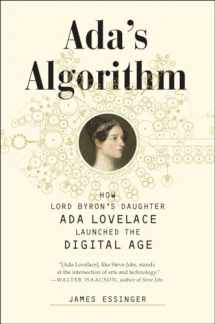
Ada's Algorithm: How Lord Byron's Daughter Ada Lovelace Launched the Digital Age
ISBN-13:
9781612194080
ISBN-10:
1612194087
Edition:
1
Author:
James Essinger
Publication date:
2014
Publisher:
Melville House
Format:
Hardcover
272 pages
Category:
United States
,
Historical
FREE US shipping
Book details
ISBN-13:
9781612194080
ISBN-10:
1612194087
Edition:
1
Author:
James Essinger
Publication date:
2014
Publisher:
Melville House
Format:
Hardcover
272 pages
Category:
United States
,
Historical
Summary
Ada's Algorithm: How Lord Byron's Daughter Ada Lovelace Launched the Digital Age (ISBN-13: 9781612194080 and ISBN-10: 1612194087), written by authors
James Essinger, was published by Melville House in 2014.
With an overall rating of 3.6 stars, it's a notable title among other
United States
(Historical) books. You can easily purchase or rent Ada's Algorithm: How Lord Byron's Daughter Ada Lovelace Launched the Digital Age (Hardcover) from BooksRun,
along with many other new and used
United States
books
and textbooks.
And, if you're looking to sell your copy, our current buyback offer is $0.3.
Description
“[Ada Lovelace], like Steve Jobs, stands at the intersection of arts and technology."—Walter Isaacson, author of The Innovators
Over 150 years after her death, a widely-used scientific computer program was named “Ada,” after Ada Lovelace, the only legitimate daughter of the eighteenth century’s version of a rock star, Lord Byron. Why?
Because, after computer pioneers such as Alan Turing began to rediscover her, it slowly became apparent that she had been a key but overlooked figure in the invention of the computer.
In Ada Lovelace, James Essinger makes the case that the computer age could have started two centuries ago if Lovelace’s contemporaries had recognized her research and fully grasped its implications.
It’s a remarkable tale, starting with the outrageous behavior of her father, which made Ada instantly famous upon birth. Ada would go on to overcome numerous obstacles to obtain a level of education typically forbidden to women of her day. She would eventually join forces with Charles Babbage, generally credited with inventing the computer, although as Essinger makes clear, Babbage couldn’t have done it without Lovelace. Indeed, Lovelace wrote what is today considered the world’s first computer program—despite opposition that the principles of science were “beyond the strength of a woman’s physical power of application.”
Based on ten years of research and filled with fascinating characters and observations of the period, not to mention numerous illustrations, Essinger tells Ada’s fascinating story in unprecedented detail to absorbing and inspiring effect.
Over 150 years after her death, a widely-used scientific computer program was named “Ada,” after Ada Lovelace, the only legitimate daughter of the eighteenth century’s version of a rock star, Lord Byron. Why?
Because, after computer pioneers such as Alan Turing began to rediscover her, it slowly became apparent that she had been a key but overlooked figure in the invention of the computer.
In Ada Lovelace, James Essinger makes the case that the computer age could have started two centuries ago if Lovelace’s contemporaries had recognized her research and fully grasped its implications.
It’s a remarkable tale, starting with the outrageous behavior of her father, which made Ada instantly famous upon birth. Ada would go on to overcome numerous obstacles to obtain a level of education typically forbidden to women of her day. She would eventually join forces with Charles Babbage, generally credited with inventing the computer, although as Essinger makes clear, Babbage couldn’t have done it without Lovelace. Indeed, Lovelace wrote what is today considered the world’s first computer program—despite opposition that the principles of science were “beyond the strength of a woman’s physical power of application.”
Based on ten years of research and filled with fascinating characters and observations of the period, not to mention numerous illustrations, Essinger tells Ada’s fascinating story in unprecedented detail to absorbing and inspiring effect.


We would LOVE it if you could help us and other readers by reviewing the book
Book review

Congratulations! We have received your book review.
{user}
{createdAt}
by {truncated_author}


